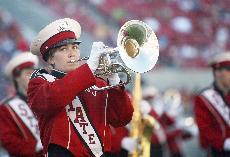
Dreier Carr
Approximately 30 aerospace seniors constructed unmanned aerial vehicles, or UAVs, to finish their degree requirements and presented them this weekend at the American Institute of Aeronautics and Astronautics conference in Florida.
With one semester for design and a second semester for constructing and testing his aerial vehicle, Christopher James Soques, a senior in aerospace engineering, compares the time put into this project to a full-time job.
“It also feels more time-consuming considering most of us have a full load of other courses along with part-time jobs,” Soques said.
The seniors make up three teams, each with separate designs. Teams Goose, Phelan, and Tandemonium worked on their fast-paced projects while applying the concepts learned in class.
“[They applied] everything from aerodynamic analysis to control sizing and structural design,” Soques said. “Each class has been the basis for this design project.”
At 6 and a half feet long and 7 feet wide, the UAVs are powered by turbo engines and made mostly of composite materials, such as carbon and fiberglass, and various woods, like plywood and balsa.
“The fact that this design had to be constructed and tested means that everything had to be calculated and accounted for,” Soques said.
To receive funding for their projects, each team submitted budget proposals for $1,500, which only included basic materials. However, these budgets did not include the jet engines, which powered the aircrafts and ran about $5,500 each.
The teams made presentations to keep track of design changes and new plans over the course of the two semesters.
According to James Ainsworth, a senior in aerospace engineering, if your plane doesn’t fly, you don’t meet your graduation requirements for aerospace vehicle design.
“Your plane either flies or it doesn’t,” he said. “If it doesn’t fly, you can still walk at graduation, but you must stay over the summer until your plane flies.”
Ainsworth mentioned the most difficult part was getting the project started. To figure out how to construct the aircrafts, teams broke the design into several parts to figure out the best ways to tackle the projects.
“You have to make it work,” he said. “You started from basically nothing, and now you’ve got a plane.”
The students presented their projects at the AIAA conference in Florida over the weekend.
As a finale to their projects, they will be presenting their aircrafts to their friends, family and anyone else interested in their aerial designs April 25 at the senior picnic located at the Harnett County Airport.
“It’s been a lot of work, but it’s been fun,” Ainsworth said. “It’s been good to watch it take off.”